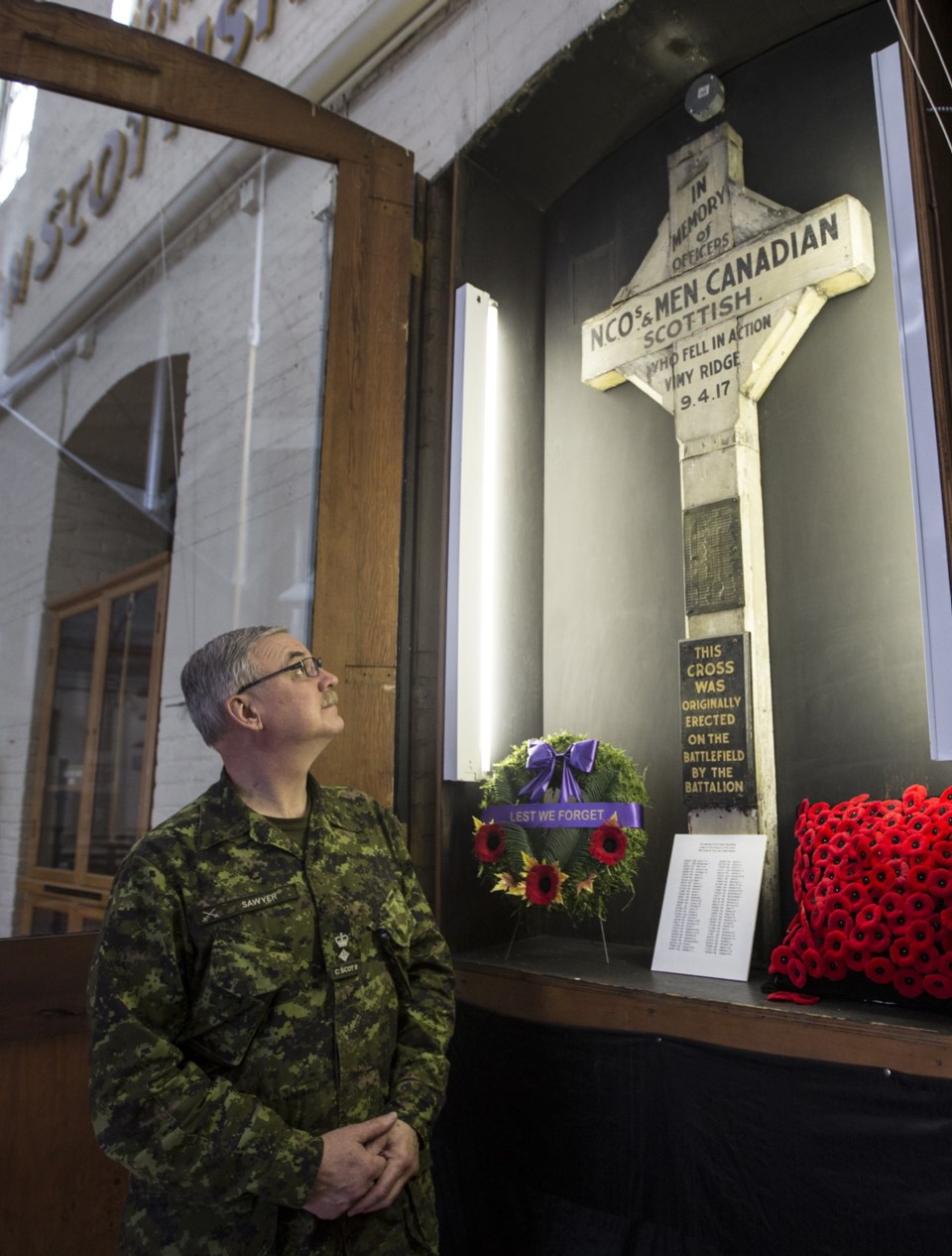Of all the items at the Bay Street Armoury, soldiers of the Canadian Scottish Regiment salute only two: The Canadian flag and the original wooden Vimy Cross.
“We always tell our soldiers: ‘You are standing on the shoulders of the men who created history,’ ” said Lt. Col. Stephen Sawyer, commander of the Canadian Scottish. “This relic, this cross, is a reminder of that history.”
Members of the 16th Battalion of the Canadian Expeditionary Forces erected the wooden cross in France during the days following April 12, 1917, regarded now as the conclusion of the Battle of Vimy Ridge.
In 1938 the cross was brought to Victoria and erected in Pioneer Square. In 1951, after a stone cross was put in its place, the wooden Vimy Cross was brought inside the armoury and preserved behind glass in a prominent place of honour.
According to Sawyer and other regimental history buffs, the wooden cross was actually unofficial. During the First World War, it was typical for soldiers to erect monuments at the site of combat actions on their own initiative.
Also unofficial was the name “Canadian Scottish,” which was not inscribed on any uniform shoulder flashes, badges or buttons. Officially, the unit was called the 16th Battalion of the Canadian Expeditionary Force.
And on the April 9, 1917, the start of the battle, the 16th Battalion was just one part of the 1st Canadian Division, one of five divisions — four Canadian and one British — going into action.
But the name “Canadian Scottish” had sprung up and grown almost by itself. People referred to men of the unit as “The Canadian Scottish.” And by the start of the Vimy Ridge battle, the men of the unit were calling themselves “The Canadian Scottish.”
Michael Heppell, former regimental commander and one-time Victoria fire chief, said the name likely arose because the 16th Division was formed by the amalgamation of four Scottish regiments, all raised in Canada.
The Gordon Highlanders, raised in Victoria, joined the Seaforth Highlanders from Vancouver, the Cameron Highlanders from Winnipeg, and the Argyll and Sutherland Highlanders from Hamilton, Ont.
Army officialdom, lacking human flair, or perhaps not wanting to be seen favouring any one of the regiments, decided the new unit would be the 16th Battalion.
But Heppell thinks soldiers, being human, preferred names over numbers, so those four Scottish regiments raised in Canada were happy being “The Canadian Scottish.”
“Numbers are just not very inspiring, so guys would give themselves their own names,” said Heppell.
And when it came time to inscribe the wooden cross at the conclusion of the battle, the men simply painted the words “In Memory of officers, NCOs & Men Canadian Scottish who fell in action Vimy Ridge 9. 4. 17.”
Nevertheless, it took army officialdom until 1920, two years after the end of hostilities, to formally decree the reserve regiment raised in Victoria would be called “The Canadian Scottish.”
Now, if they happen to be in uniform and walk past the Vimy Cross, members of the Canadian Scottish will give the relic a salute.
And every Remembrance Day, following any parades or ceremonies, members of the Canadian Scottish will gather inside the Bay Street Armoury, facing the same wooden Vimy Cross.
Afterwards, they remove the poppies from their uniforms and affix them to a cushion, leaving them at the base of the Vimy Cross until the following year.
